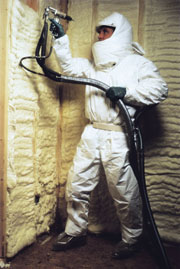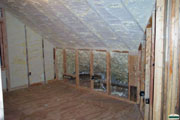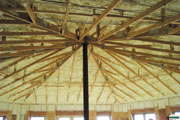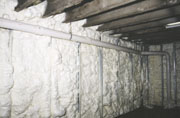

I tried Icynene because I was dissatisfied with the use of fiberglass and cellulose in difficult areas such as the rim joist area in a webbed floor truss system, knee walls in attics and in vaulted ceilings with minimal space for ventilation.
There was just no way to get these types of insulation installed well enough to provide the proper vapor retarding performance without jumping through hoops.

How can a wall be adequately insulated if outside air is moving through it?
The negative effects of poor insulation are not limited to high utility bills. Damage due to ice damming, condensation-induced structural decay and homeowner health problems may all be symptoms of inadequate insulation and ventilation. I have seen evidence of Icynene’s ability to avoid these conditions in my own projects.

Cold as ice
The winter of 2000-2001 was extremely harsh in central Iowa. We experienced conditions common to areas much farther to the north.During the month of December, temperatures were consistently below freezing, and more than two feet of snow fell. These conditions caused rampant ice damming on roofs and caused substantial damage to homes in the area. This provided an excellent opportunity to compare the performance of the different roof assemblies we had constructed on past projects.
I visited one home with cellulose insulation blown into an adequately vented attic and found no significant ice damming. So far so good. Cellulose seemed to work well if there was ventilation adequate enough to prevent a build up of the heat that escapes from the home.
I then visited another home with a vaulted second story ceiling. The rafters were 2-inch-by-12-inch lumber with 5/8-inch plywood sheeting above and 5/8-inch drywall below. The cavities were filled with dense-pack cellulose and were unventilated. The ice dams were 12-inch thick on this house, with icicles 6 feet long or longer hanging from the gutters. The roof, interior ceiling and soffit suffered water damage.
Next, I visited a house with an identical roof system (2-inch-by-12-inch rafters) that had been insulated with 8 inches of Icynene. The foam was applied to the underside of the roof sheeting with no ventilation. There was absolutely no ice damming on this home all winter long. Instead, the sun eventually warmed and melted the snow from the top down rather than the heat escaping from the house melting the underside.
A properly insulated home
During the construction of another house that winter, the furnace was accidentally shut down by an electrician early one afternoon. It was not turned back on until I arrived the following morning after a January night of sub-zero temperatures. The interior temperature had only dropped to 50 degrees F; the house lost less than two degrees per hour. At this rate, if a customer’s power failed during a winter storm, 24 hours could elapse before they risked damage to plumbing due to freezing.A more quantifiable example of Icynene’s superior performance is the low utility costs my customers enjoy. In a 4,200 square foot home insulated with 4 inches of Icynene in the walls and 6 inches in the ceiling, the peak monthly natural gas bill last winter was $85.78.
Compare this to the $124.37 bill paid by the owners of a 2,800 square foot home insulated with 4 inches of fiberglass batts in the walls and 12 inches of cellulose in the attic.
Customers always ask me, “Will the product pay for itself?” I hesitate to answer this question because the importance of good insulation goes beyond low utility bills. A direct comparison, however, of the natural gas costs in the above-described homes proves that it does indeed reduce heating and cooling expenses. W&C


